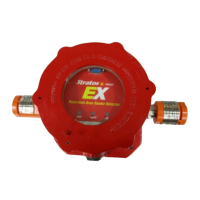Chapter 3: Installation
Stratos EX Hazardous Area Aspirating Smoke Detection System Installation Manual 19
Design
Design limitations
The EX detector is intended to provide incipient fire detection. It is suitable for the
range of applications typified by noncompartmentalised rooms, or items of
electronic or electromechanical equipment where it is desirable to achieve
incipient fire reporting. In compartmentalised rooms, each compartment would
normally use individual EX detectors.
The EX is not intended to protect large areas, or to sample from areas where
there may be any difference in airflow rates or pressure differentials. Application
of the EX in these circumstances is not recommended. If detection in
environments conforming to these descriptions is required, care must be taken to
return sampled air to the protected volume.
Maximum recommended sampling pipe length is 50 metres in still air. In areas or
applications where the external airflow rate is greater than 1 metre per second,
the maximum sampling pipe length is reduced to 25 metres.
Although by no means essential, it must be recommended that if in doubt,
PipeCAD sampling pipe modeling program be used to ensure that transit times,
balance of suction and individual sampling point sensitivity are within desired
limits.
Sampling pipes must have capped ends. The end cap should be drilled with a
hole normally between 4 and 10 mm diameter and free from burrs. Sampling
holes should normally be 2.5 to 4mm diameter or as calculated by PipeCAD, and
free from burrs. The pipe run should not have more than 10 holes (including the
end cap hole). Pipe transit time from the furthest sampling hole from the detector
must not exceed 120 seconds. To prevent potentially dangerous buildup of static
electricity, pipe networks should use metallic pipe electrically bonded to
earth/ground. It is strongly recommended that the smoke transit time from the
furthest sampling hole be checked during commissioning tests.
System design
Simple designs with short sampling pipes produce the best results. Complex
sampling pipe runs should be avoided. The use of ‘T-branch pipes is not
recommended. To assist in design and to verify system performance, it is
advisable to use the PipeCAD sampling pipe modeling software.
Always locate the sampling points in positions to which smoke may reasonably
be expected to travel. Do not expect ceiling-mounted sampling points to operate
satisfactorily if air flow from air-conditioning systems keeps the cool smoke from
an incipient fire from reaching ceiling level. In this instance it is usually better to
locate the sampling pipe directly in the airflow (for example across the return air
register of an air conditioning unit).

